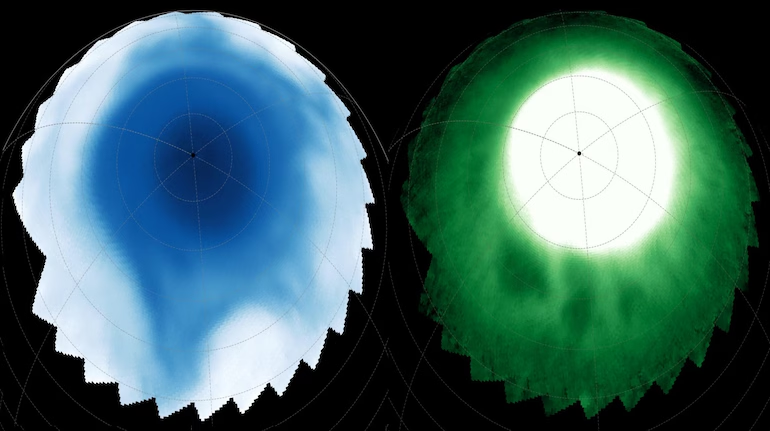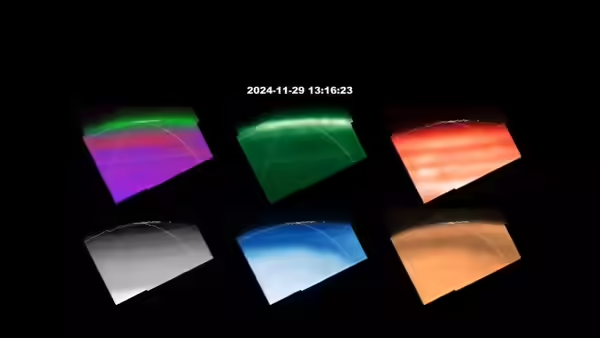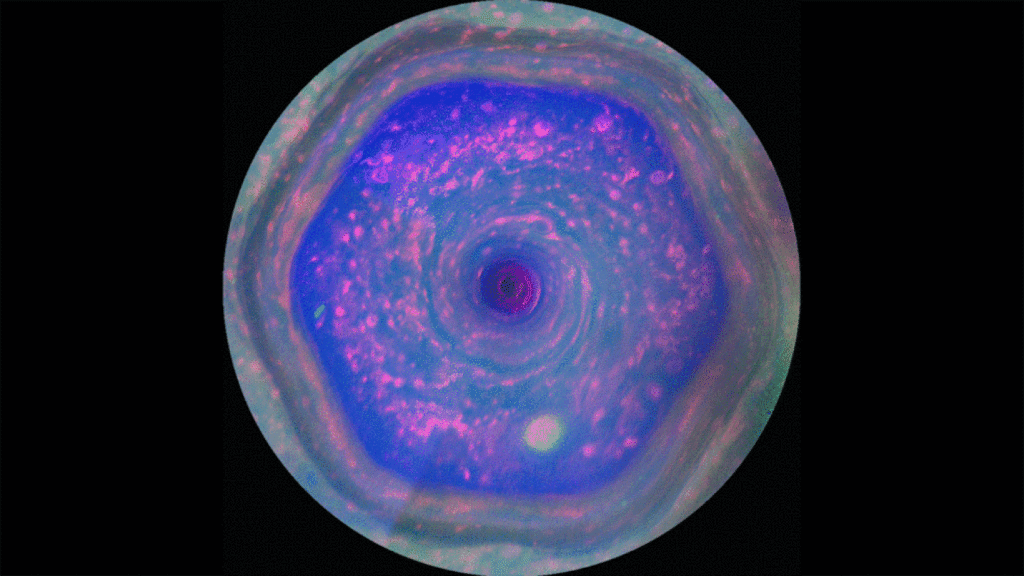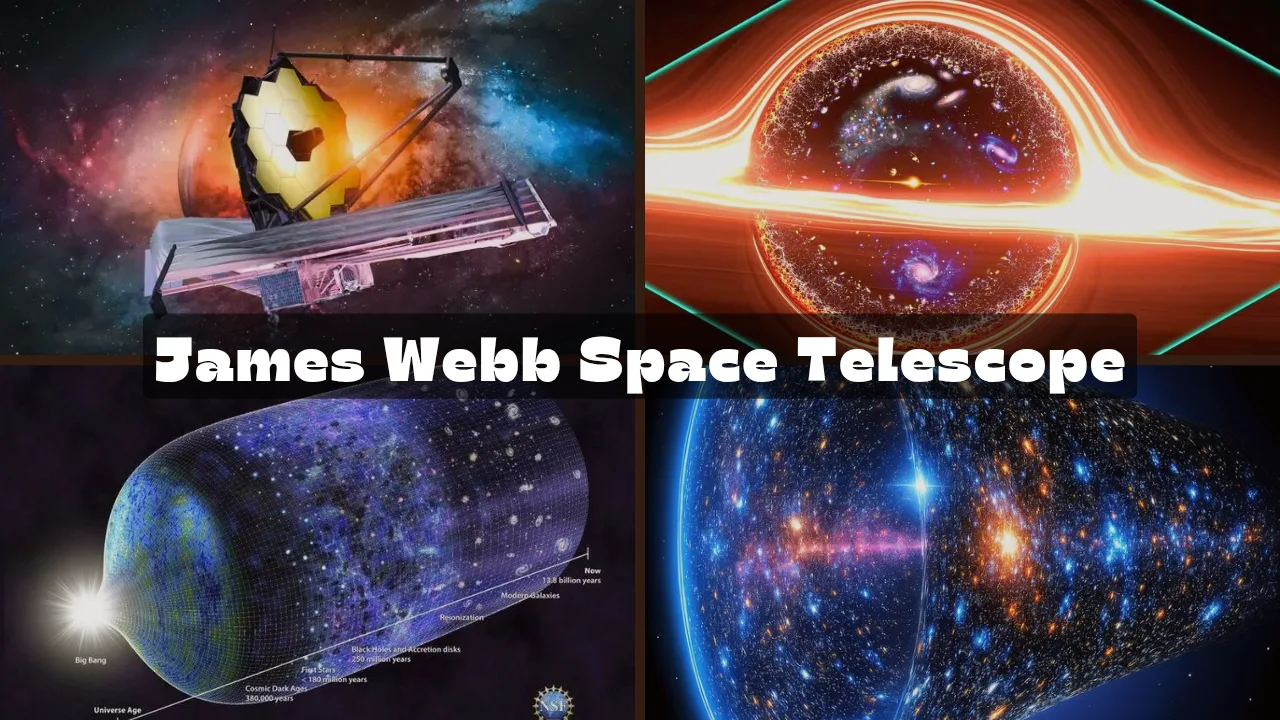The James Webb Space Telescope (JWST), renowned for its unprecedented ability to peer into the depths of the cosmos, has uncovered a phenomenon on Saturn that has left scientists baffled. Recent observations have revealed strange “dark beads” hovering above the planet’s iconic hexagonal jet stream at the north pole, along with an asymmetric star-shaped pattern unlike anything seen before.
Published in Geophysical Research Letters on August 28, these discoveries raise more questions than answers about the dynamic forces shaping Saturn’s upper atmosphere.
Saturn’s Iconic Hexagon: A Landmark of Planetary Science
First identified in 1980 by NASA’s Voyager mission and later captured in extraordinary detail by the Cassini spacecraft, Saturn’s north pole is home to a massive six-sided vortex. Spanning 18,000 miles (29,000 kilometers) across, this hexagon rotates roughly once every 10 hours, driven by powerful jet streams.
Scientists have long been intrigued by this geometric storm, but many aspects of its behavior remain unclear. The James Webb Telescope has now revealed that the mystery deepens far above the hexagon, in atmospheric layers rarely observed in such detail.
The Role of JWST’s NIRSpec Instrument
To investigate Saturn’s ionosphere and stratosphere, astronomers turned to JWST’s Near Infrared Spectrograph (NIRSpec), targeting regions roughly 600–1,100 kilometers above the planet’s visible clouds. Unlike past ground-based or spacecraft instruments, JWST offers unmatched sensitivity, enabling scientists to detect faint emissions and fine structures invisible until now.
Also Read: Possible Signs of Ancient Life: NASA’s Perseverance Finds Potential Biosignature in Jezero Crater
Instead of the expected broad bands of infrared emissions, the telescope revealed bead-like dark spots drifting slowly in charged plasma, separated by large distances but possibly connected through atmospheric or magnetic interactions. Alongside this, a strange four-armed star pattern was recorded in the methane-rich stratosphere, with two missing arms giving it a lopsided appearance.
What Are the “Dark Beads”?

The so-called dark beads were observed between 55° and 65° north latitude, stretching across multiple longitudes.
Scientists propose that:
- They may form due to local thermospheric dynamics.
- Shearing forces between ionospheric winds could be responsible.
- They are unlikely to be caused by deeper atmospheric processes or external infalling material.
Interestingly, these beads are surrounded by brighter halos, suggesting a stark interaction between different atmospheric layers. Yet, their origin remains one of the most puzzling aspects of Saturn’s newly revealed mysteries.
The Strange Star Pattern in the Stratosphere

Alongside the beads, JWST captured a dark polar cap extending four arms of darkness toward the equator. This striking shape resembles a six-pointed star, yet two arms are conspicuously missing, leaving an asymmetric, unbalanced form.
Key highlights of the finding:
- The arms stretch below 45° north latitude.
- No known analog exists on any other planet.
- The structure may be linked to atmospheric changes in underlying layers.
This asymmetric pattern has left scientists both intrigued and cautious, as no existing models can fully explain how such a structure forms in Saturn’s stratosphere.
Why This Discovery Matters
These revelations mark the first time Saturn’s upper atmosphere has been seen in such unprecedented detail. For decades, both ground-based telescopes and spacecraft missions like Cassini struggled to measure the faint emissions from Saturn’s ionosphere and stratosphere.

The James Webb Telescope has changed that, providing data enhanced by orders of magnitude. This breakthrough enables:
- Fresh insight into Saturn’s atmospheric chemistry and dynamics.
- A chance to revisit unanswered questions left by Cassini.
- New comparative studies across planets, as such features have no parallels elsewhere in the solar system.
Challenges in Interpretation
Despite the excitement, researchers emphasize that these discoveries remain unexplained phenomena.

Tom Stallard, professor of astronomy at Northumbria University in the U.K., noted that the features were “completely unexpected and, at present, are completely unexplained.”
The combination of ionospheric beads and the star-like stratospheric arms suggests highly complex dynamics at play. Future modeling and follow-up observations will be crucial in understanding whether these structures are temporary, recurring, or driven by deep planetary processes.
A New Frontier in Planetary Science
For now, the dark beads and lopsided star pattern above Saturn stand as reminders of how little we truly know about giant planets. What began as an attempt to map faint emissions has turned into a cosmic puzzle with no immediate answers.
This discovery not only reignites curiosity about Saturn but also demonstrates the transformative power of the James Webb Space Telescope in planetary science. As researchers continue to analyze data, Saturn may soon reveal secrets that could reshape our understanding of gas giant atmospheres across the universe.
Saturn’s Hidden Mystery Points Toward Deeper Truths
The detection of unexplained “dark beads” and a strange asymmetric star-like structure over Saturn’s north pole opens a new frontier in planetary exploration. These features challenge long-standing models of atmospheric and magnetic interactions, reminding us that even within our solar system, extraordinary phenomena await discovery.
While the precise origins of these structures remain unknown, one thing is certain: Saturn is far from fully understood, and the James Webb Telescope has just scratched the surface of its mysteries. Future studies may not only explain these enigmatic shapes but also deepen humanity’s grasp of how planets behave in the broader cosmos.
Spiritual Wisdom Beyond Science: The Knowledge of Saint Rampal Ji Maharaj
While modern science continues to push the boundaries of discovery such as the James Webb Telescope unraveling Saturn’s mysteries the spiritual path goes far beyond. According to the sacred knowledge revealed by Tatvdarshi Saint Rampal Ji Maharaj, the Supreme God is Kabir Sahib, the Creator of the entire universe and all realms of existence. Science, no matter how advanced, ultimately reaches its limits; but spirituality begins where science ends.
The true purpose of human life is not only to explore creation but to attain salvation (moksha) through devotion to the Supreme God. One day, everything in this material world will perish. Science indeed sharpens our intellect and helps us understand creation, but it is God Himself who designed science. Recognizing the Creator is possible only through the guidance of a Tatvdarshi Saint.
Saint Rampal Ji Maharaj is the only living spiritual teacher who has revealed the complete truth about creation ; knowledge that no one had explained before. Through authentic evidence from the holy scriptures of Hinduism, Islam, and Christianity, he has shown that Kabir Sahib alone is the Supreme God and the Creator of all.
For those seeking eternal peace, liberation, and the true meaning of life, the spiritual knowledge of Saint Rampal Ji Maharaj provides a path beyond the limits of science and into the eternal truth of God’s creation.
🔗 For more authentic spiritual knowledge, visit: www.jagatgururampalji.org
FAQs on James Webb Telescope’s Discovery of Dark Beads on Saturn
1. What did the James Webb Space Telescope discover on Saturn?
The James Webb Telescope detected mysterious “dark beads” above Saturn’s north pole and a strange star-like structure in the stratosphere. These features have never been observed before and remain unexplained.
2. Where were the dark beads found on Saturn?
The dark beads were located in Saturn’s sub-auroral ionosphere, between 55° and 65° north latitude, drifting slowly in the planet’s upper atmosphere.
3. What causes the strange dark beads in Saturn’s atmosphere?
Scientists believe the beads may be formed by shears between ionospheric winds or thermospheric dynamics, but their exact origin is still unknown.
4. What is unusual about the star-like pattern discovered by JWST?
In Saturn’s stratosphere, JWST detected a six-armed star pattern, but two arms are missing, making the structure oddly asymmetric and unlike anything seen on other planets.
5. Why is this discovery important for planetary science?
This is the first time Saturn’s upper atmosphere has been observed in such detail. The findings challenge existing models, offering fresh insight into giant planet atmospheres and their dynamics.

















